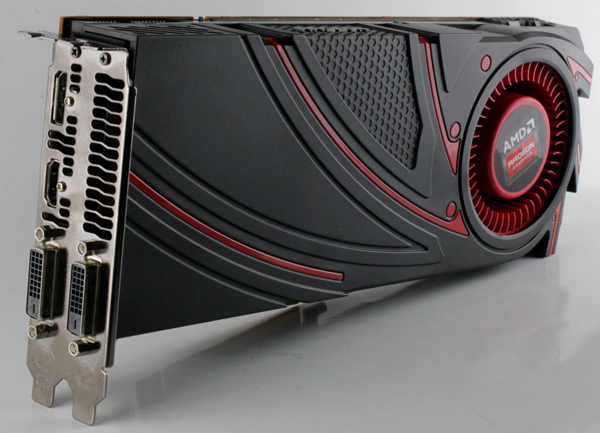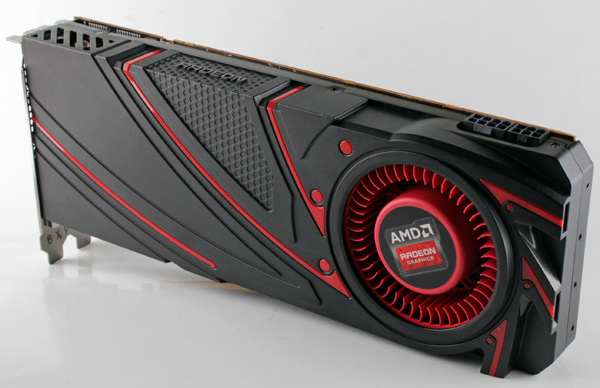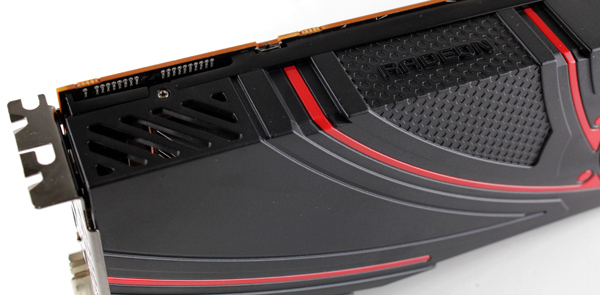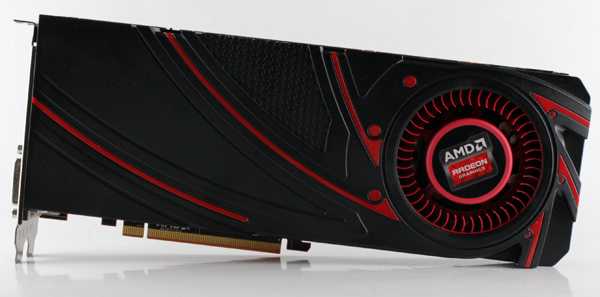Index
The R9 290X card is 27.6cm long, 11cm tall and it is a dual-slot design. The cooler sports a black plastic casing for the cover. Hot air is blown out of the case.

The card has two dual-link DVI outs, one standard HDMI and standard DisplayPort outs. Next generation 4K (4096x2160) and UHD (3840x2160) resolutions are supported. New R9-series cards are a bit better compared to the HD 7000-series when it comes to using multiple displays thanks to AMD’s display controller hardware updates. If you are using a three-monitor setup, you no longer have to use DisplayPort for the third one; you can use two DVIs and an HDMI connector. You can also combine any combination of display connectors or use all outputs at the same time. Please note that the DVI outputs no longer support analogue monitors. One HDMI 1.4a compatible sound device is built in the GPU, which also includes HD audio and Blu-ray 3D movies support so there is no need to connect the card to your motherboard’s/soundcard’s SPDIF out to get audio and video via HDMI.
The Radeon R9 290X draws power via a 6-pin power connector and another 8-pin power connector. This configuration is good for up to 300 W of power draw. According to AMD, the typical draw is around 250W.

The VBIOS switch allows you to choose between “Quiet mode” And “Über mode”. The default BIOS position (left position) is going to run the card a bit quieter (with the fan targeting 2200RPM) with a bit of a performance penalty. BIOS position two will make the cooler run faster (maxing out at about 3100RPM), so it will give you a few extra frames, accompanied with plenty of noise. If you want to change from normal to Über mode you should shut down, adjust the switch, boot up and hit defaults in Catalyst Control Center. Note how the Über BIOS doesn’t do much other than speed up the fan, therefore it is possible to get similar results by simply adjusting the fan speed manually. Speed it up and you’ll get higher average clocks, along with more noise. We will discuss PowerTune 2 clocks a bit later.
Note that the card lacks a Crossffire connector. All the communication between chained cards is now handled via PCIe 3.0. According to AMD, this will not affect performance and it actually enables 4K CrossFire.
The secret to good cooling of the GTX 780/780Ti/Titan is a good vapour chamber design, which also allows engineers to come up with compact yet powerful heatsinks that don’t look like porcupines, with heatpipes sticking out of them. AMD's new cooler on the R9 290X also uses a large vapour chamber baseplate to accommodate heat generated by the GPU core, but it is not as efficient as Nvidia’s latest coolers. Nvidia’s GPUs have a bigger surface area, so they dissipate heat more quickly, but we are convinced there are other reasons as well.
However, AMD partners now have a chance to shine. They can show who’s top dog in cooler design and we’ve already learned that several of them are working on custom solutions, but we have to wait and see how good they’ll actually be.
The reference cooler cools the memory chips and voltage regulation circuitry. The card has 4GB of memory, all the modules are at the front of the PC. AMD is using GDDR5 memory chips made by SK Hynix, model number H5GQ2H24AFR-R0C. They are specified to run at 1500 MHz (6000 MHz GDDR5 effective).
AMD decided to use the Rectifier IR 3567B controller which is functionally very similar to the CHiL controllers but unfortunately it is not fully supported in current versions of overclocking tools. We tried Afterburner beta and it does not allow for voltage adjustment, but this support will be probably added in later versions.
